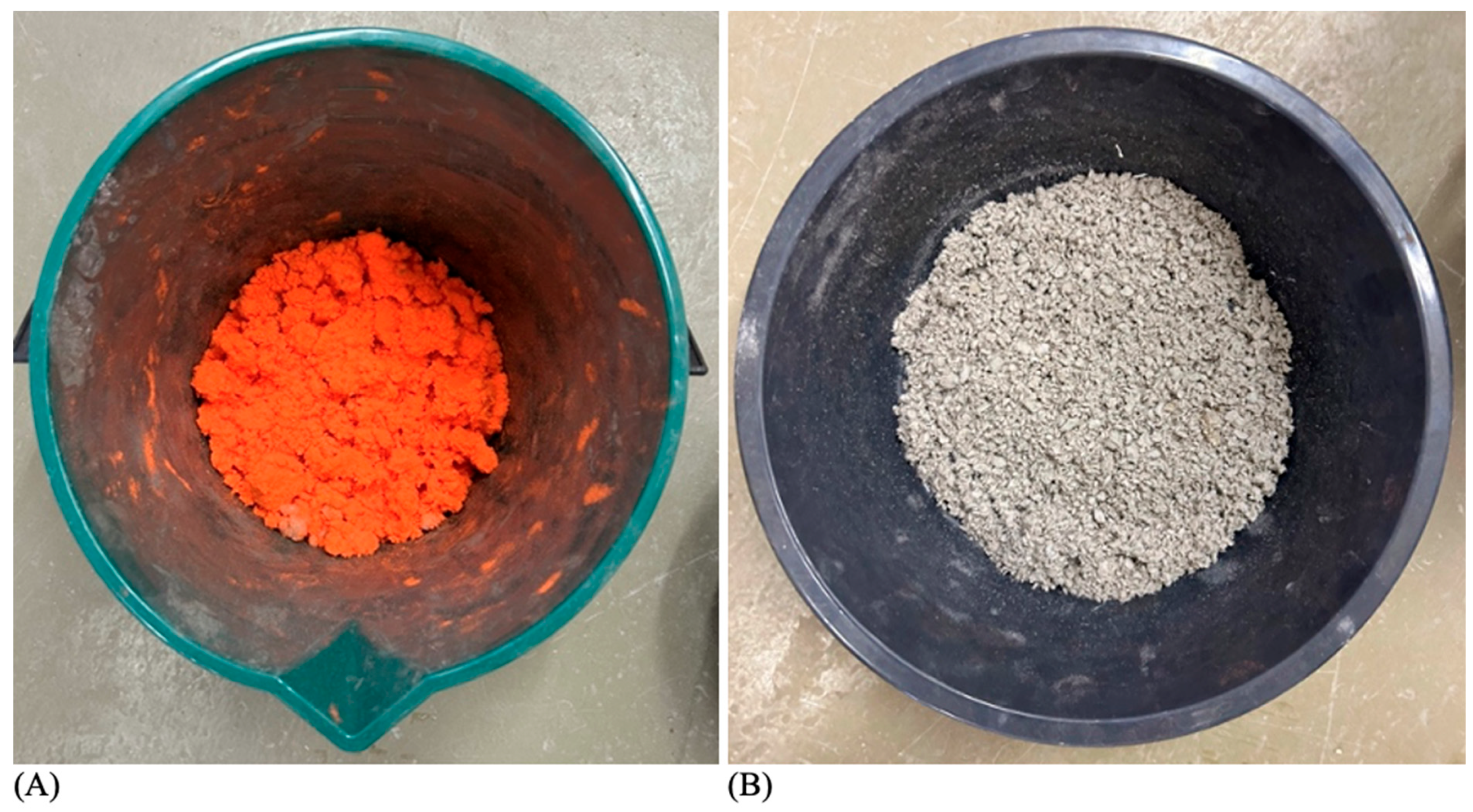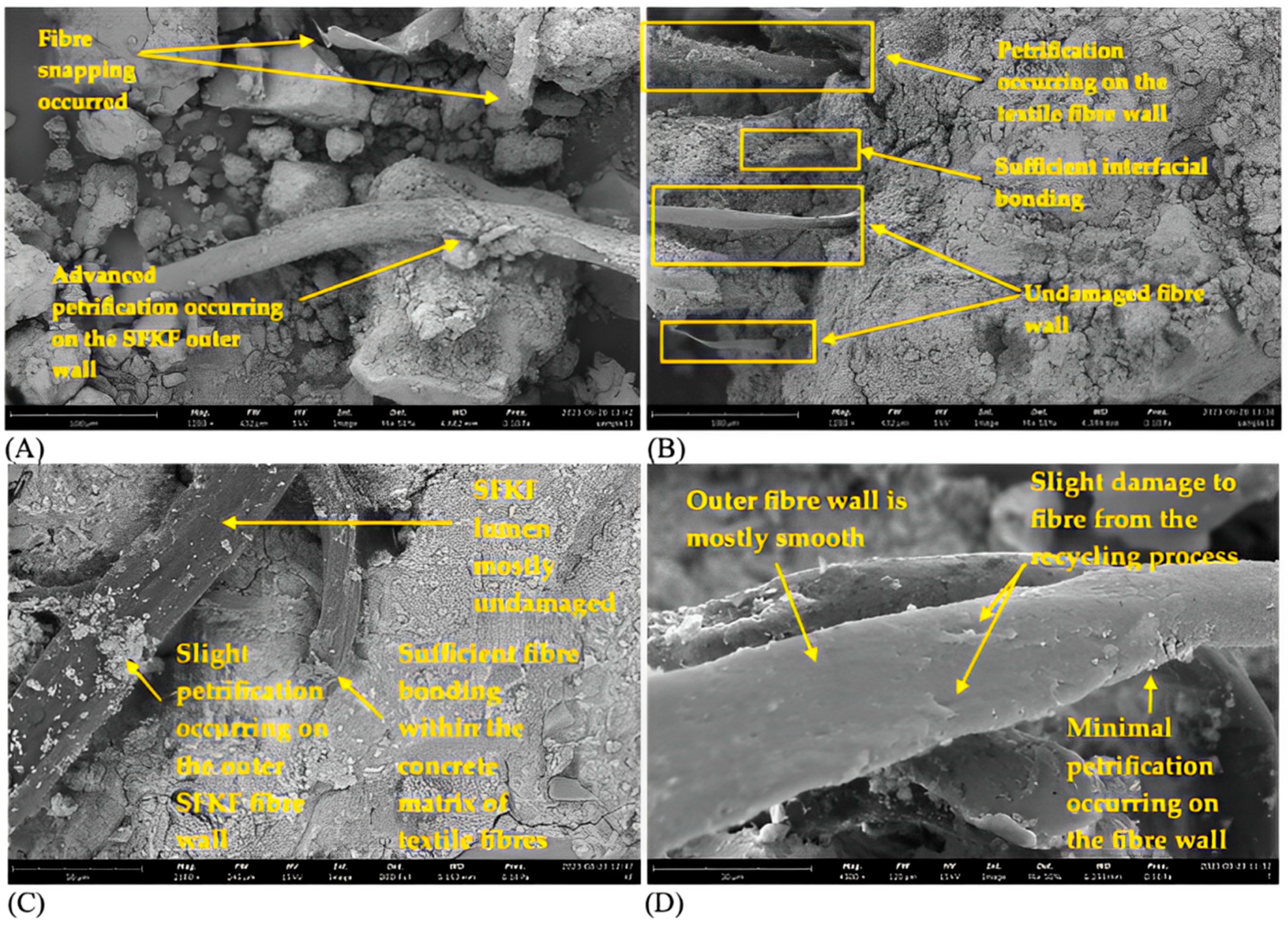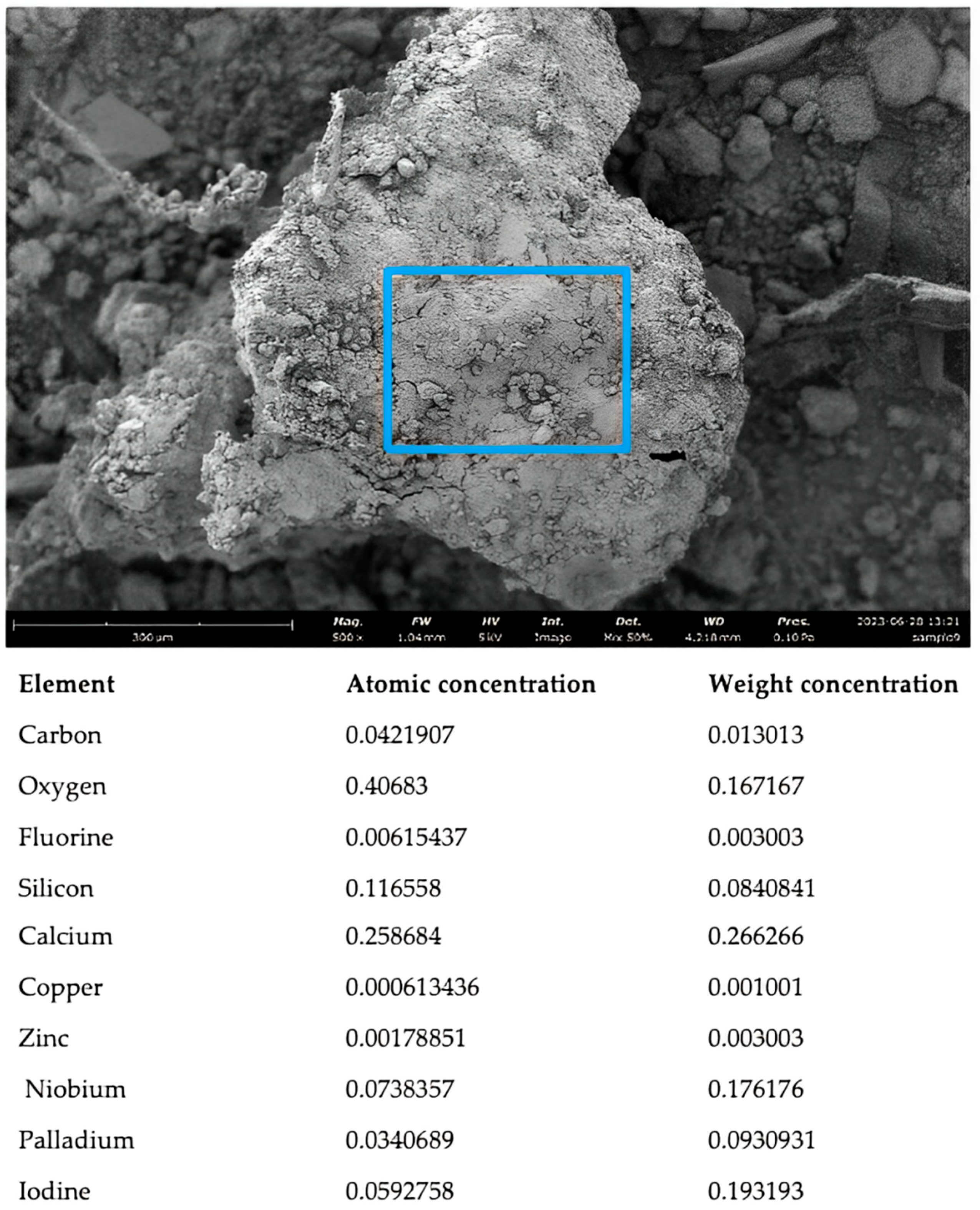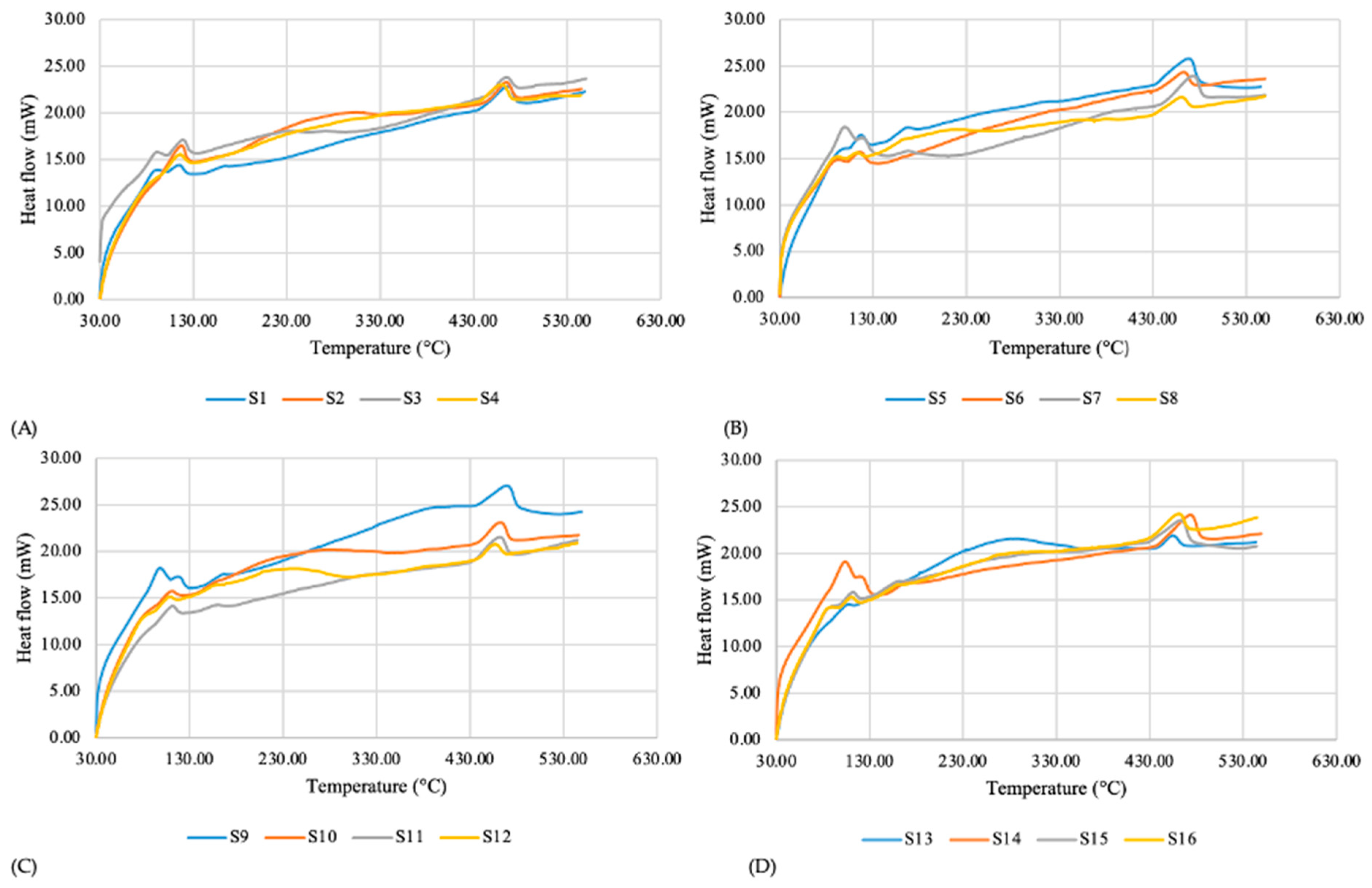The Thermo-Phase Change Reactivity of Textile and Cardboard Fibres in Varied Concrete Composites
Abstract
:1. Introduction
2. Methodology
3. Materials
4. Testing Procedure
4.1. Scanning Electron Microscope (SEM)
4.2. Thermo-Gravimetric Analysis (TGA)
4.3. Differential Scanning Calorimetry (DSC)
5. Results and Discussion
5.1. Microstructure Investigations
5.2. Thermal Properties (TGA and DSC)
6. Conclusions and Future Research
- Reduced thermal degradation when using gypsum in concrete materials.
- Using both SF and MK have a stable thermal reaction despite varied percentages.
- Natural fibres degrade significantly faster than textile fibres at similar temperatures.
- SF enhances composite thermal durability more than MK.
- SFKFs have a slower heat flow in response to the increased temperature.
- Textile fibres have higher endothermic peaks corresponding with crystallization.
Author Contributions
Funding
Institutional Review Board Statement
Informed Consent Statement
Data Availability Statement
Conflicts of Interest
References
- Kumaresan, M.; Sindhu Nachiar, S.; Anandh, S. Implementation of waste recycled fibers in concrete: A review. Mater. Today Proc. 2022, 68, 1988–1994. [Google Scholar] [CrossRef]
- Nikbin, I.M.; Dezhampanah, S.; Charkhtab, S.; Mehdipour, S.; Shahvareh, I.; Ebrahimi, M.; Pournasir, A.; Pourghorban, H. Life cycle assessment and mechanical properties of high strength steel fiber reinforced concrete containing waste PET bottle. Constr. Build. Mater. 2022, 337, 127553. [Google Scholar] [CrossRef]
- Iorio, M.; Santarelli, M.L.; González-Gaitano, G.; González-Benito, J. Surface modification and characterization of basalt fibers as potential reinforcement of concretes. Appl. Surf. Sci. 2018, 427, 1248–1256. [Google Scholar] [CrossRef]
- Kathirvel, P.; Murali, G. Effect of using available GGBFS, silica fume, quartz powder and steel fibres on the fracture behavior of sustainable reactive powder concrete. Constr. Build. Mater. 2023, 375, 130997. [Google Scholar] [CrossRef]
- Dong, W.; Li, W.; Wang, K.; Luo, Z.; Sheng, D. Self-sensing capabilities of cement-based sensor with layer-distributed conductive rubber fibres. Sens. Actuators A Phys. 2020, 301, 111763. [Google Scholar] [CrossRef]
- Bai, R.; Zhang, J.; Yan, C.; Liu, S.; Wang, X.; Jiang, Z. Waste rubber-modified sulfur-fly ash-sand composites as low CO2-emission cements. Mater. Chem. Phys. 2023, 306, 128060. [Google Scholar] [CrossRef]
- Trung Duc Pham, L.; Woo, U.; Choi, K.-K.; Choi, H. Tensile characteristics of carbon textile-reinforced mortar incorporating short amorphous metallic and nylon fibers under designed environmental conditions. Constr. Build. Mater. 2022, 352, 129059. [Google Scholar] [CrossRef]
- Ahmad, A.; Adil, M.; Khalil, A.; Rahman, M. Mechanical properties and durability of boardcrete blocks prepared from recycled cardboard. J. Build. Eng. 2021, 33, 101644. [Google Scholar] [CrossRef]
- Haigh, R. The mechanical behaviour of waste plastic milk bottle fibres with surface modification using silica fume to supplement 10% cement in concrete materials. Constr. Build. Mater. 2024, 416, 135215. [Google Scholar] [CrossRef]
- Kočí, V.; Vejmelková, E.; Koňáková, D.; Pommer, V.; Grzeszczyk, S.; Matuszek-Chmurowska, A.; Mordak, A.; Černý, R. Basic physical, mechanical, thermal and hygric properties of reactive powder concrete with basalt and polypropylene fibers after high-temperature exposure. Constr. Build. Mater. 2023, 374, 130922. [Google Scholar] [CrossRef]
- Zhang, T.; Zhang, Y.; Zhu, H.; Yan, Z. Characterizing the thermal properties of hybrid polypropylene-steel fiber reinforced concrete under heat exposure: Insights into fiber geometry and orientation distribution. Compos. Struct. 2021, 275, 114457. [Google Scholar] [CrossRef]
- Hassanpour, M.; Hassanpour, M.; Rezaie, M.; Salajegheh, E.; Iqbal Faruque, M.R.; Khandaker, M.U.; Bradley, D.A. Studies of the mechanical and neutron shielding features of concrete by incorporation of green additive materials: Experimental and numerical study. Radiat. Phys. Chem. 2022, 191, 109846. [Google Scholar] [CrossRef]
- Haigh, R. A Decade Review of Research Trends Using Waste Materials in the Building and Construction Industry: A Pathway towards a Circular Economy. Waste 2023, 1, 935–959. [Google Scholar] [CrossRef]
- Bai, B.; Chen, J.; Bai, F.; Nie, Q.; Jia, X. Corrosion effect of acid/alkali on cementitious red mud-fly ash materials containing heavy metal residues. Environ. Technol. Innov. 2024, 33, 103485. [Google Scholar] [CrossRef]
- Sandanayake, M.; Gunasekara, C.; Law, D.; Zhang, G.; Setunge, S.; Wanijuru, D. Sustainable criterion selection framework for green building materials—An optimisation based study of fly-ash Geopolymer concrete. Sustain. Mater. Technol. 2020, 25, e00178. [Google Scholar] [CrossRef]
- Dai, X.; Aydin, S.; Yardimci, M.Y.; De Schutter, G. Rheology and structural build-up of sodium silicate- and sodium hydroxide-activated GGBFS mixtures. Cem. Concr. Compos. 2022, 131, 104570. [Google Scholar] [CrossRef]
- Yan, Z.; Sun, Z.; Yang, J.; Yang, H.; Ji, Y.; Hu, K. Mechanical performance and reaction mechanism of copper slag activated with sodium silicate or sodium hydroxide. Constr. Build. Mater. 2021, 266, 120900. [Google Scholar] [CrossRef]
- Phoo-ngernkham, T.; Maegawa, A.; Mishima, N.; Hatanaka, S.; Chindaprasirt, P. Effects of sodium hydroxide and sodium silicate solutions on compressive and shear bond strengths of FA–GBFS geopolymer. Constr. Build. Mater. 2015, 91, 1–8. [Google Scholar] [CrossRef]
- Wang, Y.; Zhao, J. Comparative study on flame retardancy of silica fume-based geopolymer activated by different activators. J. Alloys Compd. 2018, 743, 108–114. [Google Scholar] [CrossRef]
- Zhang, H.Y.; Liu, H.Y.; Kodur, V.; Li, M.Y.; Zhou, Y. Flexural behavior of concrete slabs strengthened with textile reinforced geopolymer mortar. Compos. Struct. 2022, 284, 115220. [Google Scholar] [CrossRef]
- Cholostiakow, S.; Koutas, L.N.; Papakonstantinou, C.G. Geopolymer versus cement-based textile-reinforced mortar: Diagonal compression tests on masonry walls representative of infills in RC frames. Constr. Build. Mater. 2023, 373, 130836. [Google Scholar] [CrossRef]
- Majstorović, F.; Sebera, V.; Mrak, M.; Dolenec, S.; Wolf, M.; Marrot, L. Impact of metakaolin on mechanical performance of flax textile-reinforced cement-based composites. Cem. Concr. Compos. 2022, 126, 104367. [Google Scholar] [CrossRef]
- Butler, M.; Mechtcherine, V.; Hempel, S. Experimental investigations on the durability of fibre–matrix interfaces in textile-reinforced concrete. Cem. Concr. Compos. 2009, 31, 221–231. [Google Scholar] [CrossRef]
- Souza, L.O.d.; Souza, L.M.S.d.; de Andrade Silva, F. Mechanical autogenous recovery and crack sealing of natural curauá textile reinforced concrete. Constr. Build. Mater. 2020, 235, 117476. [Google Scholar] [CrossRef]
- Zhang, H.Y.; Yan, J.; Kodur, V.; Cao, L. Mechanical behavior of concrete beams shear strengthened with textile reinforced geopolymer mortar. Eng. Struct. 2019, 196, 109348. [Google Scholar] [CrossRef]
- Tamburini, S.; Natali, M.; Garbin, E.; Panizza, M.; Favaro, M.; Valluzzi, M.R. Geopolymer matrix for fibre reinforced composites aimed at strengthening masonry structures. Constr. Build. Mater. 2017, 141, 542–552. [Google Scholar] [CrossRef]
- Mohr, B.J.; Biernacki, J.J.; Kurtis, K.E. Supplementary cementitious materials for mitigating degradation of kraft pulp fiber-cement composites. Cem. Concr. Res. 2007, 37, 1531–1543. [Google Scholar] [CrossRef]
- Booya, E.; Gorospe, K.; Das, S. Performance of engineered pulp fibre reinforced composites subjected to weathering conditions. J. Build. Eng. 2019, 25, 100816. [Google Scholar] [CrossRef]
- Booya, E.; Gorospe, K.; Ghaednia, H.; Das, S. Durability properties of engineered pulp fibre reinforced concretes made with and without supplementary cementitious materials. Compos. Part B Eng. 2019, 172, 376–386. [Google Scholar] [CrossRef]
- Gencel, O.; Nodehi, M.; Yavuz Bayraktar, O.; Kaplan, G.; Benli, A.; Gholampour, A.; Ozbakkaloglu, T. Basalt fiber-reinforced foam concrete containing silica fume: An experimental study. Constr. Build. Mater. 2022, 326, 126861. [Google Scholar] [CrossRef]
- Bagaria, A.; Juneja, D. Experimental research on influence of marble powder, silica fume and polypropylene fiber on the porous concrete. Mater. Today Proc. 2023, in press. [CrossRef]
- Misseri, G.; Rovero, L.; Galassi, S. Analytical modelling bond behaviour of polybenzoxazole (PBO) and glass Fibre Reinforced Cementitious Matrix (FRCM) systems coupled with cement and gypsum matrixes: Effect of the Cohesive Material Law (CML) shape. Compos. Part B Eng. 2021, 223, 109090. [Google Scholar] [CrossRef]
- Durgun, M.Y. Effect of wetting-drying cycles on gypsum plasters containing ground basaltic pumice and polypropylene fibers. J. Build. Eng. 2020, 32, 101801. [Google Scholar] [CrossRef]
- Rovero, L.; Galassi, S.; Misseri, G. Experimental and analytical investigation of bond behavior in glass fiber-reinforced composites based on gypsum and cement matrices. Compos. Part B Eng. 2020, 194, 108051. [Google Scholar] [CrossRef]
- Saidi, M.; Gabor, A. Iterative analytical modelling of the global behaviour of textile-reinforced cementitious matrix composites subjected to tensile loading. Constr. Build. Mater. 2020, 263, 120130. [Google Scholar] [CrossRef]
- Romero-Gómez, M.I.; Silva, R.V.; Flores-Colen, I.; Rubio-de-Hita, P. Mechanical performance of waste fishing net fibre-reinforced gypsum composites. Constr. Build. Mater. 2023, 387, 131675. [Google Scholar] [CrossRef]
- Zhu, C.; Zhang, J.; Peng, J.; Cao, W.; Liu, J. Physical and mechanical properties of gypsum-based composites reinforced with PVA and PP fibers. Constr. Build. Mater. 2018, 163, 695–705. [Google Scholar] [CrossRef]
- Kuqo, A.; Mai, C. Mechanical properties of lightweight gypsum composites comprised of seagrass Posidonia oceanica and pine (Pinus sylvestris) wood fibers. Constr. Build. Mater. 2021, 282, 122714. [Google Scholar] [CrossRef]
- Rahman, T.; Lutz, W.; Finn, R.; Schmauder, S.; Aicher, S. Simulation of the mechanical behavior and damage in components made of strain softening cellulose fiber reinforced gypsum materials. Comput. Mater. Sci. 2007, 39, 65–74. [Google Scholar] [CrossRef]
- Romero-Gómez, M.I.; Silva, R.V.; Costa-Pereira, M.F.; Flores-Colen, I. Thermal and mechanical performance of gypsum composites with waste cellulose acetate fibres. Constr. Build. Mater. 2022, 356, 129308. [Google Scholar] [CrossRef]
- Coutts, R.S.P. A review of Australian research into natural fibre cement composites. Cem. Concr. Compos. 2005, 27, 518–526. [Google Scholar] [CrossRef]
- AS/NZS-3582.3; Supplementary Cementitious Materials. Part 3: Amorphous Silica. Australian Standards: Sydney, Australia, 2016.
- ASTM-C-618; Standard Specification for Coal Fly Ash and Raw or Calcined Natural Pozzolan for Use in Concrete. American Society Testing & Materials: West Conshohocken, PA, USA, 2019.
- AS/NZS-3972; General Purpose and Blended Cements. Australia Standards: Sydney, Australia, 2010.
- AS/NZS-1141.6.2; Methods for Sampling and Testing Aggregates—Particle Density and Water Absorption of Coarse Aggregate—Pycnometer Method. Australia Standards: Sydney, Australia, 2016.
- AS/NZS-1141.5; Methods for Sampling and Testing Aggregates—Particle Density and Water Absorption of Fine Aggregate. Australia Standards: Sydney, Australia, 2000.
- Independent_Cement_&_Lime_Pty_Ltd. Safety Data Sheet. General Purpose Cement. 2017. Available online: https://media.prod.bunnings.com.au/api/public/content/88f5cb7e973949fd8b09e81df5658cc1?v=426ada7a (accessed on 2 March 2024).
- MiSwaco. Safety Data Sheet. Gypsum. 2015. Available online: https://aplng.com.au/wp-content/uploads/2021/08/GYPSUM-SDS.pdf (accessed on 23 March 2024).
- Master_Builders_Solutions. Safety Data Sheet. Silica Fume. 2023. Available online: https://assets.master-builders-solutions.com/en-ca/masterlife-sf-100-sds_en_ca.pdf (accessed on 23 March 2024).
- Advanced_Cement_Technologies. Safety Data Sheet. Metakaolin. 2024. Available online: https://www.metakaolin.com/safety-data-sheet-sds/ (accessed on 23 March 2024).
- AS/NZS-1012.2; Methods of Testing Concrete. Preparing Concrete Mixes in the Laboratory. Australia Standards: Sydney, Australia, 2014.
- AS_1379-2007; Specification and Supply of Concrete. Australia Standards: Sydney, Australia, 2017.
- AS/NZS-1012.3.1; Methods of Testing Concrete. Determination of Properties Related to the Consistency of Concrete—Slump Test. Australia Standards: Sydney, Australia, 2014.
- Chen, J.J.; Ng, P.L.; Chu, S.H.; Guan, G.X.; Kwan, A.K.H. Ternary blending with metakaolin and silica fume to improve packing density and performance of binder paste. Constr. Build. Mater. 2020, 252, 119031. [Google Scholar] [CrossRef]
- Guo, Z.; Jiang, T.; Zhang, J.; Kong, X.; Chen, C.; Lehman, D.E. Mechanical and durability properties of sustainable self-compacting concrete with recycled concrete aggregate and fly ash, slag and silica fume. Constr. Build. Mater. 2020, 231, 117115. [Google Scholar] [CrossRef]
- Frýbort, A.; Všianský, D.; Štulířová, J.; Stryk, J.; Gregerová, M. Variations in the composition and relations between alkali-silica gels and calcium silicate hydrates in highway concrete. Mater. Charact. 2018, 137, 91–108. [Google Scholar] [CrossRef]
- Khan, M.I.; Siddique, R. Utilization of silica fume in concrete: Review of durability properties. Resour. Conserv. Recycl. 2011, 57, 30–35. [Google Scholar] [CrossRef]
- Júnior Carvalho Machado, P.; Alberto dos Reis Ferreira, R.; Aparecida de Castro Motta, L.; Pasquini, D. Characterization and properties of cementitious composites with cellulose fiber, silica fume and latex. Constr. Build. Mater. 2020, 257, 119602. [Google Scholar] [CrossRef]
- Martínez-Barrera, G.; Gencel, O.; Martínez-López, M. Polyester polymer concrete modified by polyester fibers and gamma rays. Constr. Build. Mater. 2022, 356, 129278. [Google Scholar] [CrossRef]
- Losanno, D.; Madera Sierra, I.E.; Spizzuoco, M.; Marulanda, J.; Thomson, P. Experimental performance of unbonded polyester and carbon fiber reinforced elastomeric isolators under bidirectional seismic excitation. Eng. Struct. 2020, 209, 110003. [Google Scholar] [CrossRef]
- Haigh, R.; Sandanayake, M.; Bouras, Y.; Vrcelj, Z. A review of the mechanical and durability performance of kraft-fibre reinforced mortar and concrete. Constr. Build. Mater. 2021, 297, 123759. [Google Scholar] [CrossRef]
- Prins, M.J.; Ptasinski, K.J.; Janssen, F.J.J.G. Torrefaction of wood. J. Anal. Appl. Pyrolysis 2006, 77, 28–34. [Google Scholar] [CrossRef]
- Wei, J.; Meyer, C. Degradation of natural fiber in ternary blended cement composites containing metakaolin and montmorillonite. Corros. Sci. 2017, 120, 42–60. [Google Scholar] [CrossRef]








| Mix Code | OPC (Weight) | Polyester Textile (Volume) | Silica Fume Kraft Fibres (Volume) | Gypsum (Weight) | SF (Weight) | MK (Weight) |
|---|---|---|---|---|---|---|
| S1 | 100 | |||||
| S2 | 90 | 5 | 5 | |||
| S3 | 85 | 5 | 5 | |||
| S4 | 95 | 5 | ||||
| S5 | 95 | 5 | ||||
| S6 | 95 | 2.5 | 2.5 | |||
| S7 | 95 | 5 | ||||
| S8 | 90 | 5 | 5 | |||
| S9 | 92.5 | 2.5 | 2.5 | 2.5 | ||
| S10 | 90 | 5 | 5 | |||
| S11 | 90 | 5 | 5 | |||
| S12 | 85 | 5 | 5 | 5 | ||
| S13 | 85 | 5 | 5 | 5 | ||
| S14 | 87.5 | 2.5 | 5 | 5 | ||
| S15 | 87.5 | 2.5 | 5 | 5 | ||
| S16 | 85 | 5 | 5 | 2.5 | 2.5 |
| Chemical | Material Component% | |||
|---|---|---|---|---|
| OPC | Gypsum | SF | MK | |
| SiO2 | ≥0.3–<1 | |||
| Al2Si2O5(OH)4 | 97.5–100 | |||
| CaSO4 | 60–100 | |||
| CaO | >92 | |||
| Silica, amorphous, fumed, cryst.-free | <1 | ≥75–<100 | <0.1 | |
| CaSO4.2H2O | 3–8 | |||
| CaCO3 | 0–7.5 | |||
Disclaimer/Publisher’s Note: The statements, opinions and data contained in all publications are solely those of the individual author(s) and contributor(s) and not of MDPI and/or the editor(s). MDPI and/or the editor(s) disclaim responsibility for any injury to people or property resulting from any ideas, methods, instructions or products referred to in the content. |
© 2024 by the authors. Licensee MDPI, Basel, Switzerland. This article is an open access article distributed under the terms and conditions of the Creative Commons Attribution (CC BY) license (https://creativecommons.org/licenses/by/4.0/).
Share and Cite
Haigh, R.; Sandanayake, M.; Joseph, P.; Arun, M.; Yaghoubi, E.; Vrcelj, Z.; Sasi, S. The Thermo-Phase Change Reactivity of Textile and Cardboard Fibres in Varied Concrete Composites. Sustainability 2024, 16, 3221. https://doi.org/10.3390/su16083221
Haigh R, Sandanayake M, Joseph P, Arun M, Yaghoubi E, Vrcelj Z, Sasi S. The Thermo-Phase Change Reactivity of Textile and Cardboard Fibres in Varied Concrete Composites. Sustainability. 2024; 16(8):3221. https://doi.org/10.3390/su16083221
Chicago/Turabian StyleHaigh, Robert, Malindu Sandanayake, Paul Joseph, Malavika Arun, Ehsan Yaghoubi, Zora Vrcelj, and Soorya Sasi. 2024. "The Thermo-Phase Change Reactivity of Textile and Cardboard Fibres in Varied Concrete Composites" Sustainability 16, no. 8: 3221. https://doi.org/10.3390/su16083221






